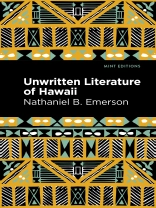Unwritten Literature of Hawaii: The Sacred Songs of the Hula (1909) is a collection of hulas and essays by Nathaniel B. Emerson. Translating previously unwritten songs, interviewing native Hawaiians, and consulting the works of indigenous historians, Emerson provides an entertaining and authoritative look at one of Hawaii’s most cherished traditions. “For an account of the first hula we may look to the story of Pele. On one occasion that goddess begged her sisters to dance and sing before her, but they all excused themselves, saying they did not know the art. At that moment in came little Hiiaka, the youngest and the favorite. […] When banteringly invited to dance, to the surprise of all, Hiiaka modestly complied. The wave-beaten sand-beach was her floor, the open air her hall; Feet and hands and swaying form kept time to her improvisation.” As an American born in Hawaii who played a major role in the annexation of the islands as an author of the 1887 Constitution of the Hawaiian Kingdom, Emerson likely saw himself as a unifying figure capable of interpreting for an English-speaking audience the ancient and sacred tradition of the hula, a Polynesian dance often accompanied with instruments and chanting or singing. Combining critical analysis with samples of popular hulas in both Hawaiian and English, Emerson works to preserve part of the rich cultural heritage of the Hawaiian Islands. This edition of Nathaniel B. Emerson’s Unwritten Literature of Hawaii: The Sacred Songs of the Hula is a classic of Hawaiian literature reimagined for modern readers.
Since our inception in 2020, Mint Editions has kept sustainability and innovation at the forefront of our mission. Each and every Mint Edition title gets a fresh, professionally typeset manuscript and a dazzling new cover, all while maintaining the integrity of the original book.
With thousands of titles in our collection, we aim to spotlight diverse public domain works to help them find modern audiences. Mint Editions celebrates a breadth of literary works, curated from both canonical and overlooked classics from writers around the globe.
Tentang Penulis
Nathaniel B. Emerson (1839-1915) was an American physician and historian. Born in Waialua, Oahu, Emerson was the son of Protestant missionaries. Wounded in action as a member of the First Regiment of the Massachusetts Volunteer Infantry during the Civil War, he went on to graduate from Williams College in 1865. In 1869, he completed his studies at Columbia University College of Physicians and Surgeons and took a job at Bellevue Hospital in New York City. In 1878, he left his career as a doctor behind to return to Hawaii, where he gained a reputation as a leading historian and authority on Hawaiian mythology. In addition to his groundbreaking translation of David Malo’s historical work on the islands, Emerson published several books on Hawaii, including Unwritten Literature of Hawaii (1909) and Pele and Hiiaka: A Myth From Hawaii (1915). Despite his contribution to Hawaiian culture as a folklorist and translator, Emerson has been criticized for his role in authoring the 1887 Constitution of the Hawaiian Kingdom, known as the Bayonet Constitution, which transferred power from the native Hawaiian monarchy to American and European imperialists and their native collaborators.












